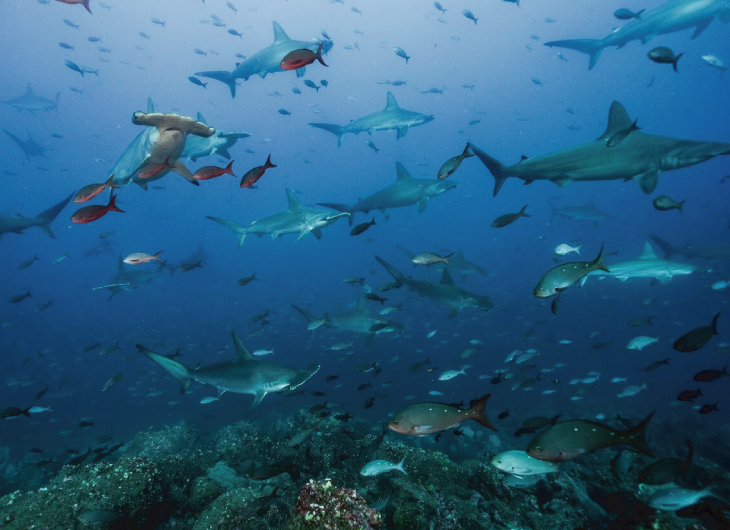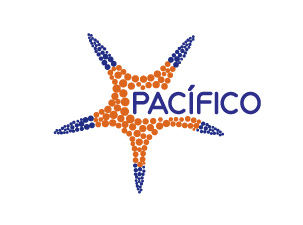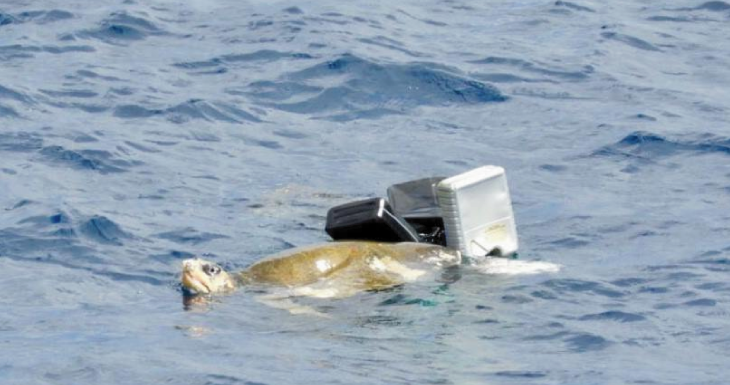- Group; of scientists save olive ridley turtle and confirm the presence of hammerhead sharks, species in danger of extinction
- 16 species of fish and aquatic mammals have been identified in the underwater mountains visited
27 April 2018. To lift anchor in an area as exuberant at the Galapagos Islands to set sail for Cocos Island could be a dream for many because of the majestic marine life in the area and the marvelous landscapes that very few have had the opportunity to see.
A group of scientists from six countries had that opportunity April 2–13, participating in an unprecedented expedition coordinated by the PACIFICO Foundation to identify migratory marine species and quantify their distribution, abundance and diversity of their predators.
“The voyage began at Baltra Island in the Galapagos Islands in Ecuador. We sailed and carried out research along the Galapagos-Cocos Marine Corridor, where we also noted the presence of seabirds, ending up on the Pacific coast of Costa Rica, for a total of 2,059 km of travel,” explained Esteban Herrera, director de protected wildlife areas, Cocos Marine Conservation Area (ACMC, Spanish acronym), Costa Rica, and a researcher on the expedition.
The route covered the Cocos volcanic range, which is the underwater range than joins the Galapagos and Cocos marine protected areas (MPAs) and visited nine sample sites in iconic places such as the north of Darwin Island in the Galapagos Marine Reserve, several underwater mountains (seamounts), such as Paramount, Medina, West Cocos and Las Gemelas, and Cocos Island.
“But the true challenge was when we observed, in open sea, a shape that appeared on the surface only with great difficulty,” said Herrera. It was an olive ridley turtle entangled in 60 kilos of fishing line and several plastic containers, evidence for a growing alarm about the increase in trash in the Pacific Ocean, which covers 1.6 million km2.
“This kind of turtle is an endangered species.[i] Without thinking, we set about to help it. We approached it and were able to bring it to the boat. We were anxious to free it because it was clearly exhausted, possibly having been trying to free itself for many days to survive,” recalled Herrera.
The olive ridley turtle was released alive and in good condition. Afterward, the expedition continued and some days later, a group of more than 50 hammerhead sharks appeared on the underwater cameras, filling the scientific community with hope, since they are also in danger of extinction. (Photos attached)
Hammerhead sharks
The hammerhead shark is a predator that uses its peculiar head to improve its chances to find prey. Its large eyes provide a greater visual range that most of its relatives and in addition, it has sensory organs along its wide mallet-shaped head that allow it to comb the depths of the ocean for food.
According to Zdenka Piskulich of the PACÍFICO Foundation, in the past 25 years, these sharks have experienced a more than 80% reduction, making them an endangered species; in spite of this growing threat, they are practically unprotected in the high seas. “The high vulnerability, long migrations of the sharks and the overfishing they suffer, both in national and international waters, highlight the clear need to protect them,” emphasized Piskulich.
Many species are caught largely in fishing for tuna and swordfish on the high seas, due to new markets for shark meat and the high commercial demand for their fins, used in preparation of shark fin soup. To satisfy consumers, the shark fins are cut off and the rest of the body is thrown into the sea.[ii]

Revealing cameras
The pelagic[iii] baited remote underwater video stations (BRUVS) used in the expedition proved to be successful offshore and at depths of from 10 to 20 meters; previously, they had only been used to gather information near coastal zones.
The BRUVS enabled the team to find and monitor the behavior of these sharks; the information gathered will be vital in the conservation of this species and to prevent its disappearance.
“The assessment of the status of this shark and other pelagic populations is very important given the rapid rate at which some species are declining. Large sharks are able to structure the marine food chains, regulating the populations of prey and/or modifying their behavior. Thus, the elimination of ocean sharks would have important ecological consequences, such as the loss of biodiversity, function and health of the ecosystem,” said Mario Espinoza of CIMAR-University of Costa Rica and participant in the expedition.
In addition, “The preliminary analysis shows that the underwater cameras recorded 16 species of fish and aquatic mammals in the submarine mountains (seamounts) visited (four shark species—hammerhead, silky, thresher and Galapagos), two sea turtle species (olive ridley and hawksbill), striped marlin, black marlin, dorado, pelagic stingrays and manta rays[G5] , pilot fish and dolphins, among others,” said Frida Lara of MigraMar, who also participated in the voyage.
This expedition, coordinated by PACÍFICO, was carried out with the Galapagos National Park Office and the Cocos Island National Park, with financing from the Waitt Foundation, the Shark Conservation Fund and the Helmsley Charitable Trust, and the significant participation of MigraMar and CIMAR of the University of Costa Rica.
“The expedition provided us with scientific information through the use of leading-edge technology that can guide decisions on management and conservation of these marine ecosystems,” said Mario Coto, executive director of the Costa Rican National System of Conservation Areas.
For his part, Jorge Carrión, director of Galapagos National Park, pointed out that “the existing corridor between Cocos Island and the Galapagos Island has never been studied—therein lies the importance of working together. This is going to provide us results for taking management measures for those migratory species that travel between Cocos and the Galapagos.”
[i] IUCN Marine Turtle Specialist Group.
[ii] International Union for the Conservation of Nature (IUCN).
[iii] That live in areas far from the coast.

